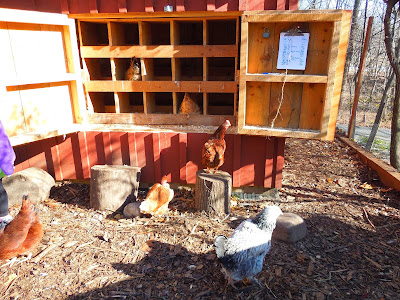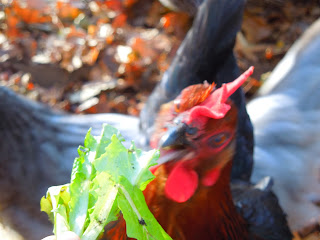Ever since I have moved into my new house, the chickens have been locked in the coop because there wasn't a suitable place to keep them confined in, we also didn't want them to bother the neighbors or let the chicks get caught by a predator. A talk with a next door neighbor had informed us that there were foxes, raccoons, hawks, and even coyotes in my backyard! So the best option since we were busy was to keep them in the coop for the whole day. I felt guilty for keeping them in there with no entertainment or area to run and frolic so a few weeks ago I decided to keep them in an old fenced up dog enclosure that the previous owner had left.
 |
| The dog pen, with two white "ornaments" on top. |
 |
| Lemon and Spice immediately flopped onto the ground to dustbath, after being deprived of it for a week. |
Of course the first few days were good, no one flew out and the chicks and Mellow quickly headed to dust-bath and scrap up leaves. But as a week passed, Lime and Charcoal my best flyers had found the ticket to freedom. All they had to do was use their power jump and fly up onto the top of the fence, which encouraged the others to follow.This was the beginning of the long lasting war. . .
 |
| Not being content with their freedom from the coop, the chickies formed the Coop d'état, a group of young rebellious teenagers that were unsatisfied with their life. |
 |
| The cold November wind blew Lime's feathers, urging her to continue and jump off the fence. |
They probably think of me as the evil woman with
The Stick, because when they do happen to get out of the fenced area, I will come out and herd them back in with a branch from a tree I had picked up in my old house, 3 years ago. And as always, poor little Mellow (who is now a midget, the baby chicks are starting to outgrow her!) is always left out, due to her shortness and irregular wing feathers. The war between the safety of the chicks and freedom happens everyday. and every minute it seems, a little chickie will make her escape, and again the evil woman with the stick will stalk the insolent, and shoo them back in. Until I get them in a permanent enclosure or buy some netting to cover the top of the fencing, the chickens will continue to escape and I will still have to chase them with a stick....
Here are some pictures in neutral times:
 |
| Spice being disturbed while taking her daily dustbath. |
 |
| A little bit of grass for the exited chickers. |
 |
| Top and bottom: The chickers are hiding in a small outdoor dog house from the cold, and basking in the sun's warmth as usual. |
 |
| Lemon foraging in the oh-so interesting leaves. |
 |
| This is how the pullets look at me under their veil of cuteness. Evil chickens! They watch me walk back in the house, with their shiny glinting eyes, full of mischief and trouble. |
As night draws near, the sun sets and the chickens happily and swiftly make their way to the coop. They walk around and bawk their complaints (because they don't want to use the energy to jump up), and Mellow will jump using her "power" jump where she finds the perfect spot to jump, crouches down, wiggles her body close the the ground, and then..., JUMPS! The other pullets follow and in the end, they all make it to the rooster bar and sleep for the night, waiting for another rebellion the following day.
 |
| The sun sets after a long day. |





















































